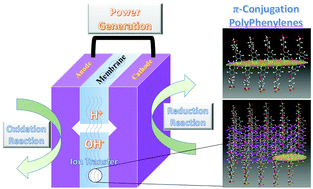Polyphenylenes and the related copolymer membranes for electrochemical device applications
Abstract
Electrochemical devices employing ion-conducting polymer electrolyte membranes (PEMs) are promising power sources for automotive and energy storage applications. The development of the next generation of membrane separator materials with excellent performance has been the aim of intense research, as has alternatives for the state-of-the-art perfluorosulfonic acid (PFSA) ionomers. Polyphenylene (PP), as a branch of aromatic PEMs, provides advantages due to the high C–C bond dissociation energy (BDE) of the phenyl–phenyl group, and has drawn much attention. This review gives an overview of polyphenylenes and their derivatives for use in cationic/anionic fuel cell (FC) and vanadium redox flow battery (VRFB) applications. In the first section, membrane categories and synthetic strategies are summarized and analyzed. Secondly, the ex situ characterizations of membranes are briefly compared and discussed, comprising ion conductivities, mechanical properties, swelling state, fuel permeabilities, etc. Meanwhile, nano-scale morphological studies are examined to obtain an insightful understanding into fundamental behaviors. Thirdly, membranes for electrochemical device applications are investigated, together with durability evaluation, using the U.S. DOE target as a standard. Collectively, this review aims to provide a better understanding of aspects of PP-based PEMs. Perspectives on future trends are also commented on.


 Please wait while we load your content...
Please wait while we load your content...